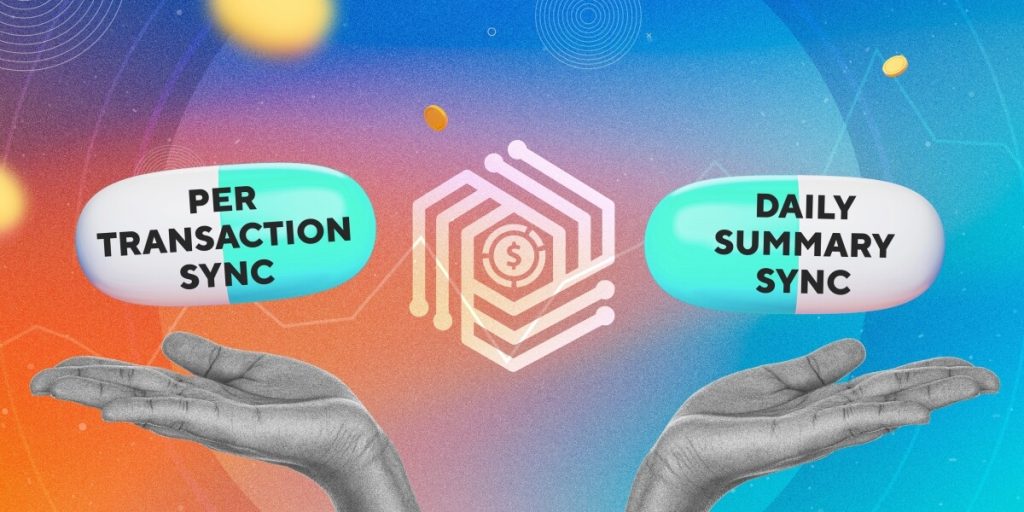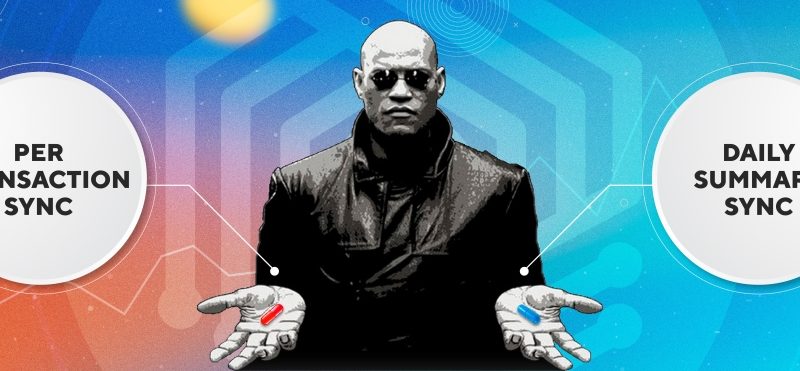Synder has been automating bookkeeping for US, UK, Canadian and Australian businesses for more than 5 years. We’ve heard many stories about the automation software that imports online sales into the books – all of which concern different issues. Some businesses can’t continue using their software because as the business grows, so do their needs, but the tool can’t keep up with their increasing demands. Companies sometimes face data issues – there are apps that bring too few details into the QuickBooks account, and you have to constantly edit entries manually to add necessary data. Others put too much information into QuickBooks, and your account slowly becomes a mess where nothing makes sense. However, business owners aren’t the only ones having automation issues – accountants with several clients have to juggle multiple apps to make sure they can meet their clients’ needs.
All of these issues come from the specific nature of the app – the mode of syncing transactions. Generally, synchronization apps can be divided into two categories: the ones that put each transaction in and the ones that import a summary of all transactions for the day. For simplicity’s sake, we can say that the former offer per transaction sync and the latter – daily summary sync of data.
Since your finances are indeed the Matrix, choosing the right scenario isn’t easy. Both types of sync are the pills your business desperately requires, but their benefits aren’t easily recognized. Let’s figure out which one would suit your business needs best so that you can pick the right pill!

“You take the blue pill… the story ends, you wake up in your bed and believe whatever you want to believe. You take the red pill… you stay in Wonderland, and I show you how deep the rabbit hole goes”
– Morpheus (The Matrix)
Contents:
1. What is per transaction sync?
2. What is daily summary sync?
3. What are the key benefits of per transaction sync and daily sync?
4. How do I choose what suits my needs?
- Go with per transaction sync if…
- Go with daily summary sync if…
- Why do accountants need to switch modes?
5. Choosing the right mode with Synder
‘Modes. Lots of modes.’
What is per transaction sync?
Per transaction sync is an automated way of entering each transaction (sale, for example) into your books separately with full information, including product names, SKU, quantities, customer name, address and email, etc. Wonder how it works in real life?
Let’s say you sell your items on Shopify and use native Shopify Payments and external PayPal payment gateway to receive payments from customers. Your QuickBooks account gets updated on an hourly basis – as soon as you receive a new sale from any of the gateways. Each sale initiates the creation of a sales receipt/invoice in your books. This receipt or invoice specifies who the customer is, what exactly they’ve bought, how many items are purchased, what the price is, what discounts are applied (if any), and what the tax amount is. A separate expense reflects payment processing fees for this particular transaction. If the sale is refunded, you’ll see a refund for the same client. All of them are separate transactions.
Synder’s per transaction sync brings in all the available data for each transaction that comes in.
So far, so good, right? Keep on reading to learn about one more option – daily summary sync.
What is daily summary sync?
Unlike per transaction sync, daily summary features only the most important thing a business needs – financial data. Sounds appealing? Let’s examine what it really means!
Daily summary sync is an automated way of bookkeeping that gathers all your sales, fees, refunds, taxes, discounts for the day and posts a single record per connected platform to your books. Let’s illustrate the flow with the same example.
You still sell through Shopify with native Shopify Payments and external PayPal payment gateways. But each day you get 2 journal entries in your QuickBooks reflecting your yesterday’s sales. The first entry shows the total amount of your payments received via Shopify Payments – itemized by sales, fees, taxes, discounts, and refunds. The second entry is identical in structure, but reflects your PayPal sales. No customer/product data is transferred to your QuickBooks.
With Synder’s daily summary sync, for example, you get one aggregated transaction per platform daily – you’ll see as many transactions as the number of connected platforms* (if the platform was used to receive payments on this day) in the books.
* With notable exceptions of Shopify and Square where the entries are additionally broken down into payment gateways.
Now that you know the difference between these two scenarios, you might wonder what the perks of each type of sync are. The devil’s in the details so you need to know what you’re dealing with in order to navigate the Matrix of your finances and choose the right pill.
What are the key benefits of per transaction sync and daily sync?
“Remember… all I’m offering is the truth. Nothing more”
– Morpheus (The Matrix)
Both per transaction sync and daily sync bring lots of benefits to the table and offer online businesses smooth automated transfer of financial data. Let’s break them down and see how they align with the functionality you need!
Per transaction sync benefits
- All invoices come through individually with customer details. Tracking invoices in QuickBooks has never been easier!
- Open invoices in your QuickBooks can be automatically closed with payments coming from payment processors. Synder pre-matches corresponding transactions. All you have to do is just check and accept!
- Your sales in QuickBooks are updated almost instantly (on an hourly basis). You always have up-to-date reports and know what to expect!
- SKUs and product names are automatically created/matched in your QuickBooks, so COGS and quantities are updated as well. No need to do it manually!
- Your books reflect your real money flow, which means you’re ready for an audit at any time. Your CFO will also thank you for detailed financial records at hand. Your books are highly ‘auditable’ – they’re transparent, forthright and provide auditors with the required information!
- If you use QuickBooks classes/locations, per transaction sync supports it. There’s nothing to edit manually!
- Since product and customer data is transferred to QuickBooks, you have access to product and customer based reports. Insights into product performance and customer behavior are right here!
Daily summary sync benefits
- Spotting an error is easy and takes little time. If you notice that you’re missing something, you just need to compare the total for the day in the daily entry and in your payment gateway. No need to look through all your transactions!
- Data in QuickBooks is straightforward. There’s only one entry for the day for each connected platform, you know what to expect!
- Your QuickBooks isn’t loaded with customer data. You’ve only got the financial info that matters!
- Your QuickBooks isn’t loaded with product details (names, SKUs, prices, quantities, etc.). You can easily find what you need!
- Daily summary is easy to set up – you simply map sales to account A, discounts to account B, taxes to account C, etc., and enjoy the automated workflow!
How do I choose what suits my needs?
“Choice. The problem is choice”
– Neo (The Matrix Reloaded)
With all the benefits each type of sync offers, it might be difficult to decide what you really need. Synder did the heavy lifting for you!
Go with per transaction sync if:
- You’re a low-transactional business, want to see each individual sale and easily navigate in your financial records.
- You use QuickBooks to send invoices and collect payments for them via external payment processors.
- You track inventory in QuickBooks.
- You want to run product/SKU based reports in QuickBooks.
- You want to run customer based reports in QuickBooks.
- You use classes and locations in QuickBooks.
Go with daily summary sync if:
- You’re a high-transactional business and want to focus on aggregated financial data.
- You use QuickBooks only for reconciliation and tax reporting.
- You don’t use QuickBooks for detailed reporting and analytics of your sales.
- You don’t invoice your clients from QuickBooks or don’t manage AR there directly.
- You don’t manage inventory in QuickBooks.
If you’re a business owner, and you’re lost in the financial Matrix of your transactions, go through the benefits of each mode again. If you’re an accountant who needs to choose the mode for your client’s business, do the same. Choosing a pill shouldn’t be a big problem now!
Why do accountants need to switch modes?
“I don’t like the idea that I’m not in control of my life”
– Neo (The Matrix)
If you happen to be an accountant who loves automation, chances are that you’ve already got the taste of many accounting solutions, seeking for the one to satisfy the requirements of all your clients. As each app serves a particular purpose and focuses on different types of businesses, depending on size, industry, etc., accountants and accounting firms wind up having multiple apps. And the more clients they have, the more issues enter the equation.
While one client may have a low volume of transactions, track inventory in QuickBooks, and want to see the real money flow, the other may have hundreds of transactions daily and want to know exactly how much their sales, fees, taxes, etc. with each payment gateway are. They need different types of sync: per transaction for the former and daily summary for the latter. Choosing one just doesn’t cut it.
So what should you do? Succumb to fate and continue dealing with several tools simultaneously? While you can try to keep up and juggle different apps to serve your clients, you might lose time adjusting to each one of them, not to mention configuring these apps to meet the needs of your clients’ businesses. Isn’t it too long and arduous?
But what if we told you that there’s a solution that allows you to serve all your clients and address numerous issues? With Synder, accountants can onboard multiple clients, selecting different sync modes for each one of them. No extra fuss!
Choosing the right mode with Synder
“I know kung-fu”
– Neo (The Matrix)
With the high level of automation available, bookkeeping for e-commerce shouldn’t be a nightmare. It’s time to use accounting kung-fu!
Synder covers the needs of businesses regardless of size, number of connected channels and platforms, as well as helps accountants to deliver quality services to a diverse range of clients. Reconciliation, reporting, inventory management and many other things can be done accurately and promptly in just a few clicks and in one source of truth.
Synder supports 25+ integrations and allows businesses to grow and add payment providers along the way, without the fear of outgrowing the solution. The integrations can be added as the business expands, and the good thing is – they come for free.
But what’s more important, Synder offers BOTH per transaction and daily sync modes, and that’s a rare thing for the financial Matrix!
Final words
“I can only show you the door, you’re the one that has to walk through it”
– Morpheus (The Matrix)
Syncing of transactions is by far the most essential part of bookkeeping, and choosing the right mode is the decision that determines how effective accounting processes are. The choice of pill depends on a number of conditions – business size, volume of transactions, level of details required. Now that you know the pros and cons of both per transaction and daily summary scenarios, compare them against the needs of your business. Which pill is yours?
Supercharge your bookkeeping efforts by signing up for a free 7-day trial with Synder if you already know what pill you want, or get a demo with our support team to see how both of them work.








.png)
